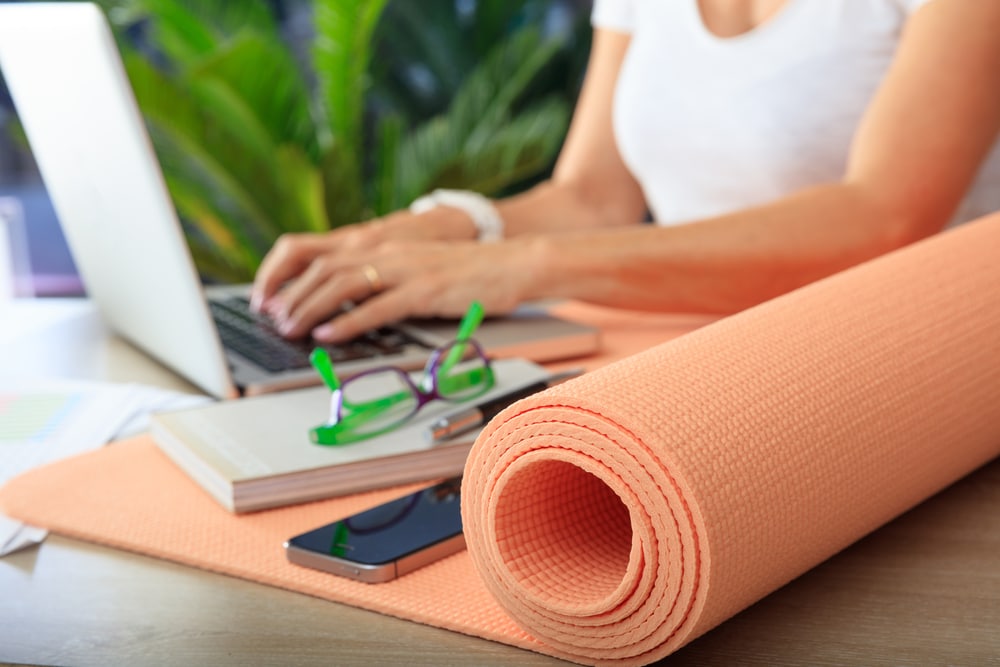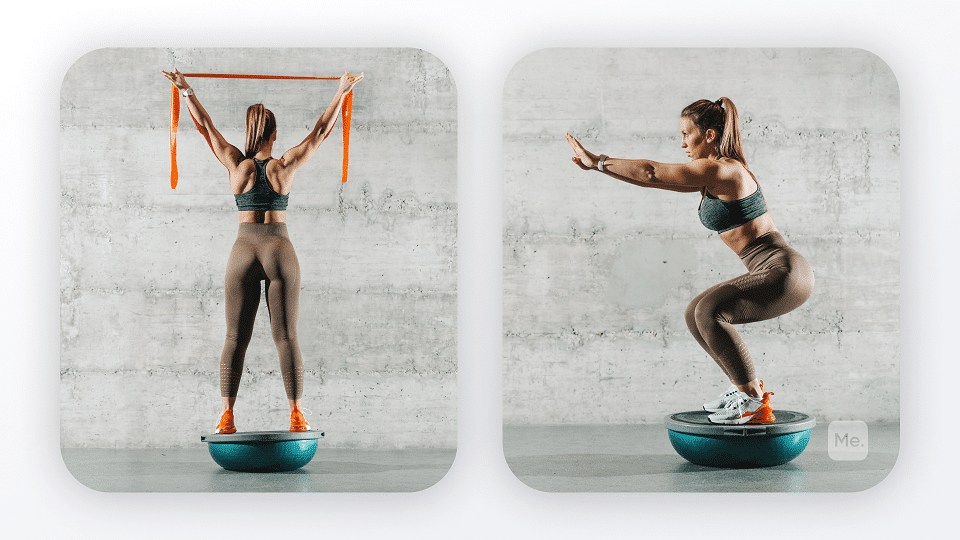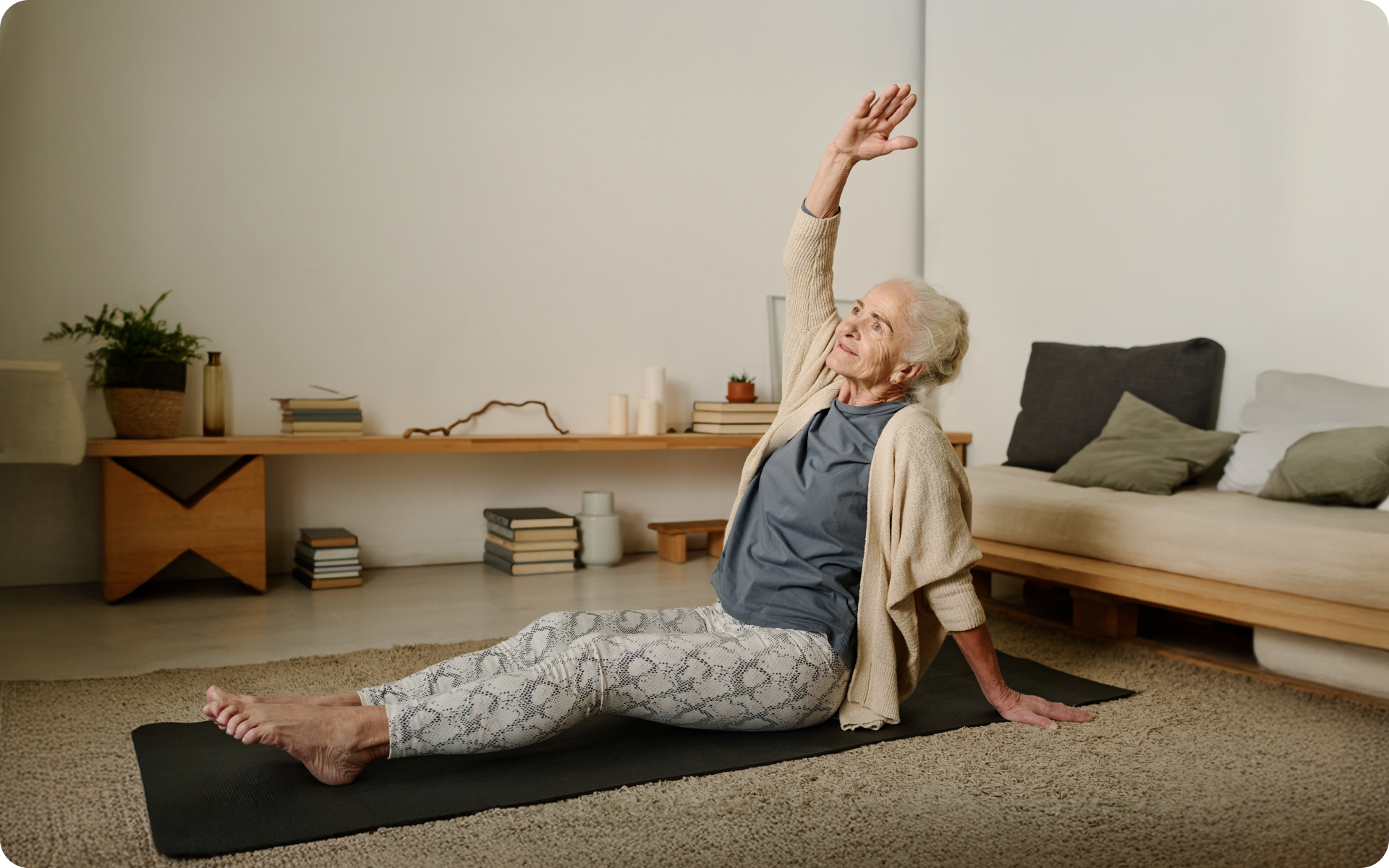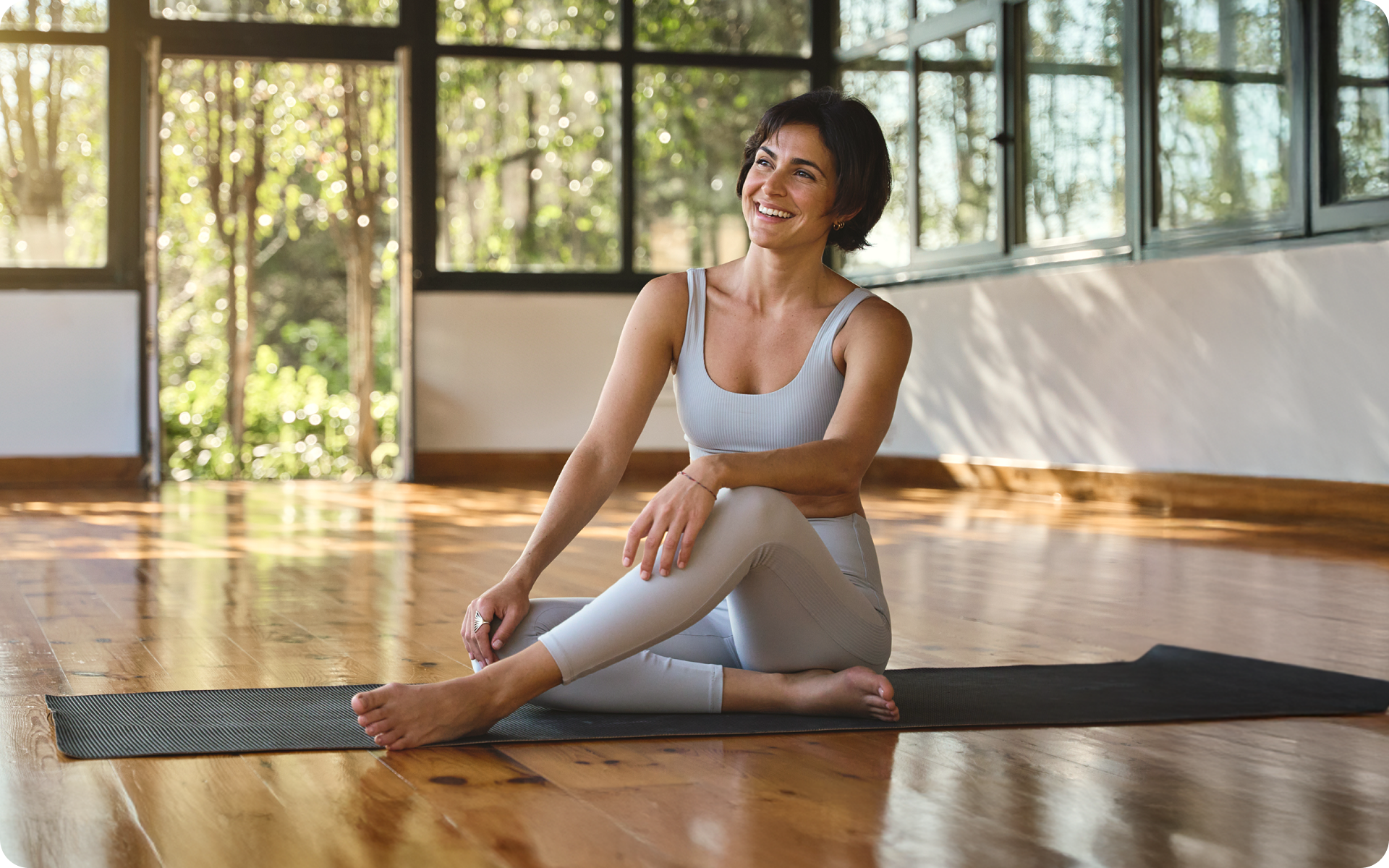Have you ever wondered how many hours you spend a day just sitting at your desk? While people who work regular corporate jobs might have an idea, people who work from home may be surprised at just how many hours a day they spend simply sitting.
The disadvantages of an inactive lifestyle are many– and all too real! From the risk of obesity, high blood pressure and heart disease, type 2 diabetes, metabolic syndrome, etc. finding a way to remain active is imperative. This is where office yoga comes in. Yoga for office workers is a simple yet gradually effective way to ensure that you are moving around throughout the day– even if you are stuck at your desk for most of it.
If this sounds like something you’d be interested to try, keep reading to find out simple yoga poses that you can do at your desk and in your office for better health, posture, flexibility, and more.
Can I Do Yoga In My Office?
Yes, you can. Many of us subconsciously do some variation of desk yoga throughout the day, especially when stretching. The trick to office yoga, particularly if you work in a shared space, is to pick simple stretches and poses that are subtle yet effective.
This is not the time for elaborate yoga asanas like the Kakasana (crow pose), downward dog, Halasana (plow pose), or even the cobra stretch. Yoga stretches appropriate for the office are those that take up less space and can be done quietly as failure to do this might result in you disrupting your coworkers, which not only affects their productivity and the smooth running of a business but could also end up with a dreaded trip to human resources.
Read More: Yoga Levels: Are You A Beginner, Intermediate, Or Advanced Yogi?
How Do You Do Yoga At Your Desk?
Here are some yoga exercises that you can do at your desk for more flexibility, tension relief, increased productivity, and much more:
Neck Rolls
Neck pain is one of the most common complaints from office workers, probably because they spend many hours looking down at documents on their desks and their computer keyboards. Research shows that taking a minute or two to do some office yoga neck rolls helps keep this area flexible and reduces the pain and strain that many of us struggle with (9).
- Begin by sitting up straight in a chair. Your back should be straight.
- Look up to the ceiling while keeping your neck long.
- Slowly bring your left ear down toward your left shoulder and hold this position.
- Roll your head down toward the ground and bring your chin to your chest. Hold for a second or two before finally rolling your head to the right and bringing that ear to your right shoulder.
- Inhale and exhale through the nose in a slow and controlled manner.
- Repeat twice or until you feel some relief from the pain or stress.
Wrist And Finger Stretch
Impressive typing skills and speed are essential in any office job/environment. However, over time the constant hand motion used in shooting off emails, memos, proposals, summaries, and updates can lead to some finger and wrist pain.
To prevent this, wrist and finger stretches are a great thing to do as part of your office yoga routine to keep this area limber:
- While sitting or standing, take the fingertips of one hand into the palm of your other hand.
- Extend that same arm forward, at shoulder-height, and gently pull your fingers down toward the back of your wrist until you feel a slight stretch.
- Do this for 5 to 10 breaths then switch hands.
To stretch each finger individually, follow the same steps as above. However, instead of pulling all your fingers down at once, pull each finger individually towards the back of the wrist.
Shoulder Rolls
For office workers, shoulder pain is mostly caused by bad posture. While this issue can be fixed by getting a proper chair and improving your posture, doing shoulder rolls is a good way to prevent and alleviate any pain that you may be having.
- Start by sitting up straight and inhaling deeply.
- On the inhale, draw the shoulders up toward your ears and back.
- Hold this position for a while then exhale, pushing your shoulders down and forward.
- Repeat this two more times and then reverse the direction of the rolling.
If you’ve mustered up the courage to crush your weight loss goal, let Betterme take the sting out of this demanding process. Our app will help you restructure your habits, remold your life and crank up your fitness results!
Office Yoga Chair Stretches For Your Back And Spine
Spine pain is another of the most common pains experienced by office workers. According to Spine Health, this pain is a result of static posture – staying in the same posture or position for long periods, usually while working – which not only increases stress on different parts of the body but also adds large amounts of pressure to the back muscles and spinal discs (3).
To help relieve this pain, here are some desk yoga back stretches to try at work:
The Seated Twist
Also known as the twisted spinal twist, it helps reduce any tightness that may be caused by prolonged sitting and increases your back’s range of motion.
- Stand and turn your chair to the side. Sit back down sideways, with either your right or left side towards the back of the chair.
- Ensure that your feet are flat on the floor.
- Turn slightly and hold the back of your chair with both hands.
- Using the chair as support, turn yourself 180 degrees so you are facing the opposite side of the chair.
- Hold this position for 30 seconds to a minute before going back to the starting position and turning 180 degrees to the other side.
Cat-Cow Stretch
This is a modified version of the traditional Marjaryasana/Bitilasana pose. Doing this stretch helps increase mobility and flexibility, and relieves any tension in your upper back, shoulder, and neck.
- Sit up straight with your feet on the floor and your hands on your knees.
- On an inhale, arch your back and look up toward the ceiling.
- Hold this position, and then on an exhale, round the spine and let your head drop forward.
- Repeat this 5 to 10 times.
Back Bend Pose
- Scooch toward the very edge at the front of your seat.
- Keep your back straight and feet flat on the floor.
- Push your chest outwards and reach your arms behind, grabbing the back of the chair and clasping your hand. Then, keep your elbows as straight as you can. If you cannot do this, hold on to the sides of the chair.
- On an inhale, pull your shoulder blades back and hold. This helps relax your shoulder.
- Exhale and relax your shoulders.
For a deeper stretch, especially for that area between the shoulder blades, pull on the chair behind you as you pull the shoulder blades back.
Read More: Yoga Poses To Avoid With High Blood Pressure: The Best And Worst Poses
Should You Switch Out Your Regular Work Chair For A Yoga Ball Office Chair?
According to the Washington Post, the popularity of stability balls went through the roof in 2020 after advertisements everywhere pushed the narrative that using these balls as an office chair helps improve your posture and facilitates a core-strengthening workout. But is this true or was it a marketing fad that helped increase the sale of exercise ball chairs everywhere?
So here are some potential benefits of using an office yoga ball chair:
Reduced Pain
One of the most common issues reported by office workers is constant back pain, which is often a result of the posture of the chair itself. Switching from an office chair to a stability ball has been shown to help relieve this pain.
According to a study published in the Journal of Occupational and Environmental Hygiene in 2012, those who are using yoga ball office chairs may experience less pain than those using regular chairs. Researchers found that the use of stability balls at work helped decrease the likelihood of reporting pain from regular office chair use from approximately 45 percent to 21 percent (6).
An earlier case report published in 2007 by the Journal of the Canadian Chiropractic Association also showed similar results. Two patients who had been suffering from low back pain reported improvements after they switched from a regular chair to using a yoga ball as a work chair (10).
In 2013, a study done on the use of stability balls for back pain in men and women saw the women in the study report experiencing less lower back pain when using these balls at work. The men, however, did not experience the same results as the women (4).
Muscle Activation
Proponents of using a stability ball claim that using one at work will help engage and activate the muscles in your core. One study published in 2017 showed that using a stability ball helps activate lower body muscles, which is essentially working out while seated (1).
Calorie Burning
This ties to the point above. Proponents of the study claim that because you need to keep the stability ball steady, it gives you a workout that results in calorie burning and could lead to weight loss. A point to note, however, is that this only relates to free-standing stability balls and not the ones that come with a tiny chair.
Improved Posture
This was one of the claims that many advertisers used when trying to sell this chair to the general public.
Reasons why BetterMe is a safe bet: a wide range of calorie-blasting workouts, finger-licking recipes, 24/7 support, challenges that’ll keep you on your best game, and that just scratches the surface! Start using our app and watch the magic happen.
Disadvantages Of Switching To The Yoga Ball Office Chair At Work
We have seen the purported benefits of this alternative office yoga chair above, but are they all true? What disadvantages may one come across while using a stability ball as a chair at work?
Here are some of those:
Bad Posture
While advertisers claim that the yoga ball will improve your posture at work, experts and research results beg to differ. According to a study published in 2019, researchers found that using this ball for extended periods will result in bad posture. In a study, ten female office workers were asked to sit on this ball and do typing work for an hour.
Researchers found that doing this resulted in more trunk motion and more variation in lumbar EMG, this activity caused more spinal shrinkage as well (7). Also known as spinal stenosis, this issue, if not rectified in time, will affect and put pressure on your nerves. This will not only lead to a bad posture but also other issues such as numbness, weakness, or tingling of the hand, arm, foot, or leg, neck pain, issues with walking and balancing, as well as bowel or bladder dysfunction in the most severe cases.
Little To No Core Activation
As mentioned above, many people who suggest the use of the yoga ball as an office chair claim that it will help activate your core muscles, which means that you get to work out while seated at work.
However, several scientific studies have shown that this is likely just a marketing fad to generate more sales. The muscle activation from using this ball is often never seen, and when seen is very minimal and almost insignificant. This means that, no, using a yoga ball office chair will not give you the abs of your dreams (5, 8, 11).
No Weight Loss
While there is some muscle activation to be seen in the lower body muscles and sometimes in the core, the activation and calorie burning are not enough to lead to any significant weight loss.
Increased Back Pain
While many of the studies above do show that the yoga ball office chair will lead to less back pain, one study published in 2013 by the Journal of Electromyography and Kinesiology showed that this leads to low activation of lumbar muscles, which is due to several factors that can lead to low back pain (2).
So should you switch out your regular work chair for a yoga ball office chair?
Seeing as the disadvantages mostly outweigh the benefits, we suggest sticking to a normal office chair while at work. If you experience lower back pain while using such chairs, speak to a doctor to find ways to treat or manage this problem. If you still insist on using the yoga ball, try not to use it for more than 30 minutes at a time.
FAQs
Can You Do Yoga While Sitting At Your Desk?
Yes, you can. All the yoga stretches and poses mentioned above are office-friendly and easy to do while seated or standing at your desk.
Is Chair Yoga As Good As Regular Yoga?
It depends on how you look at it. According to Aaptiv, chair yoga was introduced into the fitness world as an alternative to regular yoga. It was mainly meant to be used by individuals with health implications as well as the elderly.
Today, office chair yoga is mostly used by people with desk jobs as well as anyone on a long flight to help ease discomfort, reduce work stress and tension, and also to alleviate the potential risk of blood clots (12). We must say that while chair yoga does provide many of the same benefits as regular yoga, i.e. stress reduction, improving flexibility, relieving cramps and stiffness, and more, it does not burn nearly the same calories as regular yoga.
Normal yoga tends to include more muscles as well as many complicated and physically demanding poses, which results in more calorie burning and eventual weight loss.
The Bottom Line
Office yoga is a simple way to keep you active and work on your mobility and flexibility while stuck at your desk for eight hours a day– if not more. It is an effortless way to work on and prioritize your health, especially when you have no time to head to the gym.
With that being said, these desk yoga stretches are not enough for weight loss, proper calorie burning, or even improved health. So be sure to eat healthy calorie deficit meals and add simple workouts like walking and climbing stairs to your daily activities.
DISCLAIMER:
This article is intended for general informational purposes only and does not serve to address individual circumstances. It is not a substitute for professional advice or help and should not be relied on for making any kind of decision-making. Any action taken as a direct or indirect result of the information in this article is entirely at your own risk and is your sole responsibility.
BetterMe, its content staff, and its medical advisors accept no responsibility for inaccuracies, errors, misstatements, inconsistencies, or omissions and specifically disclaim any liability, loss or risk, personal, professional or otherwise, which may be incurred as a consequence, directly or indirectly, of the use and/or application of any content.
You should always seek the advice of your physician or other qualified health provider with any questions you may have regarding a medical condition or your specific situation. Never disregard professional medical advice or delay seeking it because of BetterMe content. If you suspect or think you may have a medical emergency, call your doctor.
SOURCES:
- Energy expenditure and muscular activation patterns through active sitting on compliant surfaces (2017, sciencedirect.com)
- Lumbar posture and muscular activity while sitting during office work (2013, pubmed.ncbi.nlm.nih.gov)
- Office Chair: How to Reduce Back Pain? (2010, spine-health.com)
- Should we be more on the ball? The efficacy of accommodation training on lumbar spine posture, muscle activity, and perceived discomfort during stability ball sitting (2013, pubmed.ncbi.nlm.nih.gov)
- Sitting on a chair or an exercise ball: Various perspectives to guide decision making (2006, clinbiomech.com)
- Sitting on Stability Balls: Biomechanics Evaluation in a Workplace Setting (2012, tandfonline.com)
- Static and dynamic postural loadings during computer work in females: Sitting on an office chair versus sitting on an exercise ball (2009, pubmed.ncbi.nlm.nih.gov)
- The effect of active sitting on trunk motion (2014, sciencedirect.com)
- The effectiveness of a neck and shoulder stretching exercise program among office workers with neck pain: a randomized controlled trial (2015, journals.sagepub.com)
- The gym ball as a chair for the back pain patient: A two case report (2007, ncbi.nlm.nih.gov)
- Unstable Sitting in the Workplace – Are there Physical Activity Benefits? (2016, ncbi.nlm.nih.gov)
- What Actually Is Chair Yoga and How Do I Do It? (n.d., aaptiv.com)













